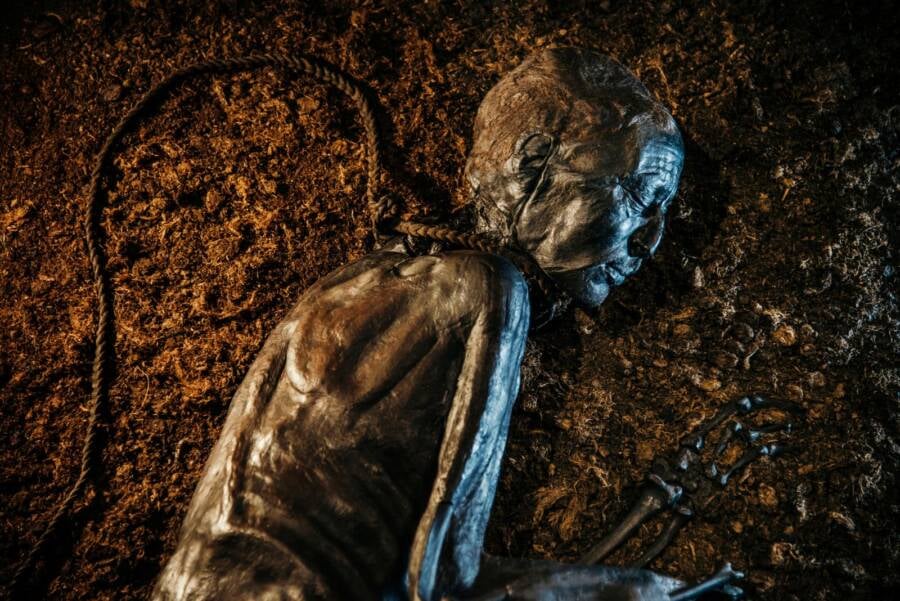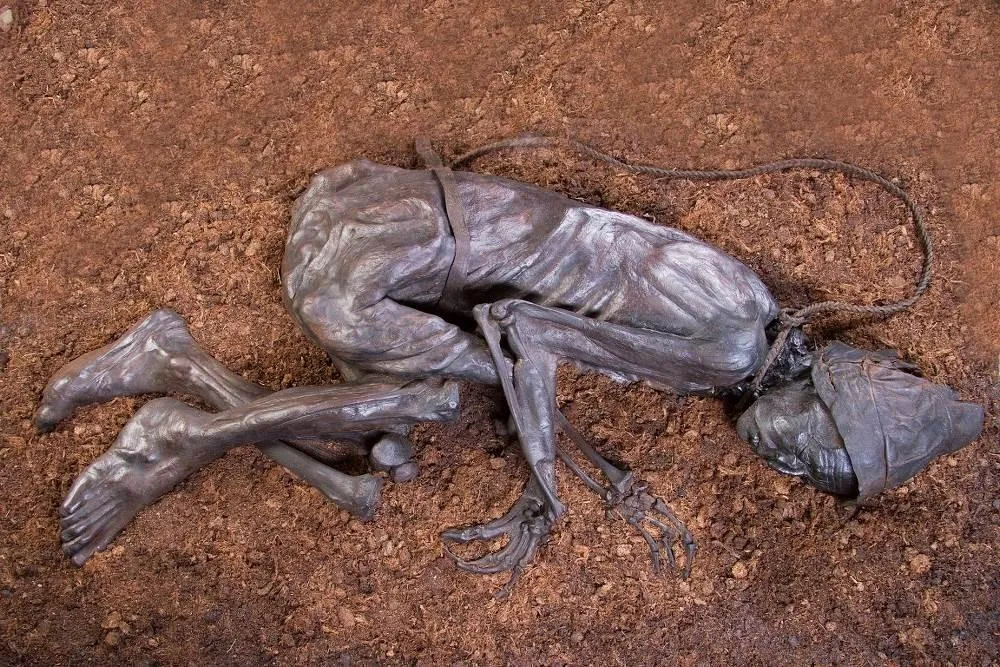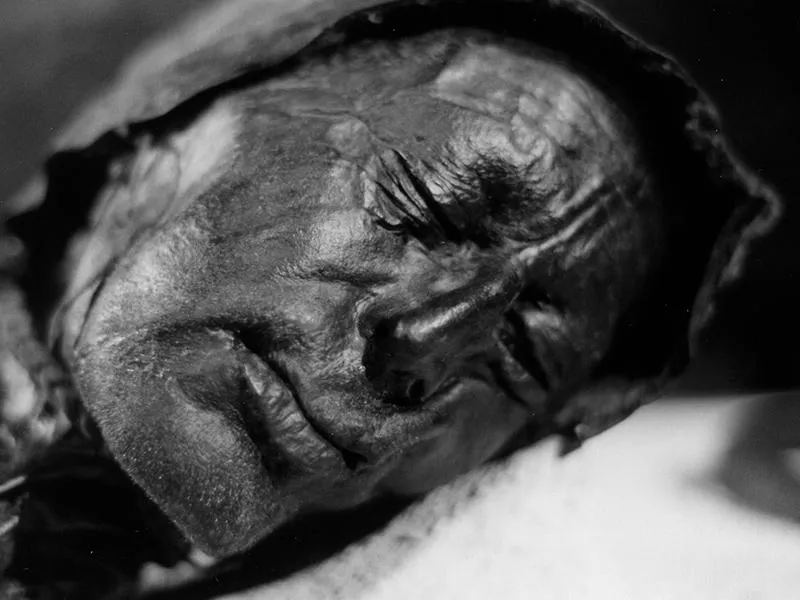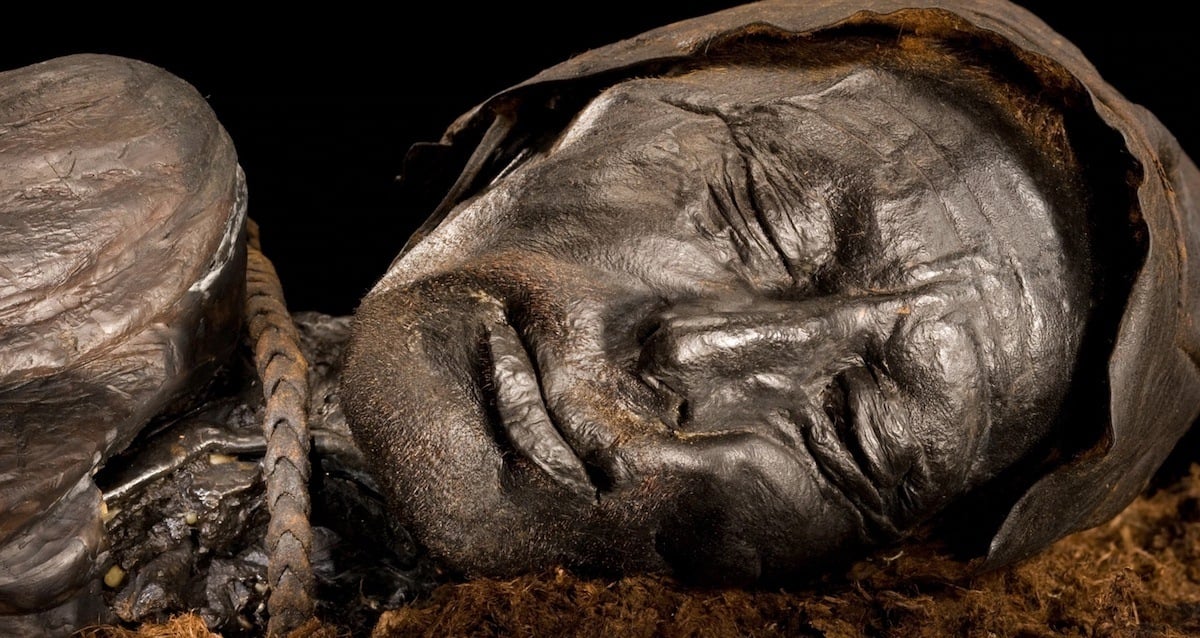One of history’s best-preserved “bog bodies,” the Tollund Man was discovered with a noose around his neck, leading researchers to conclude he’d been a victim of human sacrifice.

Christian AlsThe Tollund Man was found with a noose still tied around his neck from his execution.
On May 6, 1950, brothers Viggo and Emil Hojgaard were cutting peat on the Jutland peninsula in Denmark when they came across a body.
They immediately called the police because they thought they had stumbled across a recent murder victim. A schoolboy from Copenhagen had recently gone missing, and the body they found was a male who couldn’t be taller than 5’3″.
But despite his features suggesting he had died recently, his clothes suggested otherwise. He had a pointed cap made of sheepskin and wool as well as a noose made of braided animal hide still around his neck. His skin, hair, and nails were tanned a leathery brown.
It was soon determined that this was no recent murder victim, but instead a bog body — a corpse that is naturally mummified and preserved in a peat bog for up to thousands of years.
The man came to be known as the Tollund Man after the nearby Danish village, and the fact that he was so well-preserved after two millennia remains shocking to this day.
The Story Of The Tollund Man And The Body Left Behind

Silkeborg MuseumThe Tollund Man was found almost completely naked and posed in the fetal position.
Carbon dating determined that the remains of the Tollund Man were more than 2,000 years old, dating back to sometime between 405 and 380 B.C.E., in Scandinavia’s pre-Roman Iron Age. The man was estimated to be about 40 years old when he died by hanging.
While it was suggested that he may have been executed for being a criminal, most experts “tend to agree that [his] killing was some kind of ritual sacrifice to the gods,” wrote Joshua Levine for Smithsonian. If he was executed as a criminal, his remains would have been cremated. In fact, the leathery noose was still wrapped around his neck.
The Tollund Man’s facial features and internal organs, including his heart, lungs, and liver, were shockingly well-preserved, although the skin on his arms and hands had deteriorated to just toughened tissue and bone. The body was posed in the fetal position, with his eyes closed and his mouth relaxed into a faint smile.
The Tollund Man was in such good condition when he was discovered that scientists were able to take his fingerprints. Even his organs were found to be in good shape, and an analysis of his stomach showed that he ate his last meal between 12 and 24 hours before he died. Based on the ingredients, it had likely been some sort of porridge or gruel made primarily of flaxseed and barley.
Bog Bodies Across Northern Europe

Moesgaard MuseumBog bodies like the Tollund Man have been found in peat bogs across Northern Europe.
The overwhelming majority of bog bodies like the Tollund Man were unearthed in northern Europe and date to the Bronze and Iron Age.
According to author Christian Fischer in the book Mummies, Disease and Ancient Culture, it is estimated that 122 complete bog bodies have been found and are able to be accounted for, although some estimates put the number as high as 1,400.
Nearly all of the bog bodies that have been found appear to have been killed in some sort of ritual sacrifice or punishment, according to Smithsonian. According to archaeology professor and author Peter Vilhelm Glob, the bodies were likely sacrificed to the pagan goddess Nerthus, also known as the Earth Mother, who was associated with peace and prosperity.
The first recorded bog bodies were found back in the 17th century. One was discovered in Germany in 1640, believed to be the first bog body discovered, and a peat-cutter in Northern Ireland came across one in 1780, leading to what is believed to be the first published account of the bog bodies.
To date, the oldest bog body that has been discovered was known as the Koelbjerg Man, whose remains were dated to approximately 8000 B.C.E. His whole body was not found, only a skull and bone fragments, but it is the oldest set of human bones ever found in Denmark.
Many historians believe that many of these bog bodies could be connected. This theory was bolstered by the discovery of another bog body just 260 feet from where the Tollund Man was found. The Elling Woman, as she was called, was discovered in 1938, and carbon dating estimated her time of death to be around 280 B.C.E., just a few decades after the Tollund Man was killed.
The Science Behind The Tollund Man’s Mummification

Wikimedia CommonsA peat bog on Hill of Snowy Slack, Scotland.
Bog bodies like the Tollund Man are often referred to as being “naturally mummified” due to the incredible preservation of the bodies by the natural elements.
The water in peat bogs is highly acidic due to proximity to cold bodies of salt water, such as Scandinavia’s North Sea. The high level of salt allows peat moss to grow freely in the bog, and as the moss rots, it releases significant levels of acid into the bog.
The water in these bogs ends up with nearly the same pH balance as vinegar, leading any human remains left in the bog to be preserved in a similar manner as vegetables are pickled in vinegar, according to the Silkeborg Museum. The acid prevents bacteria from flourishing, which would cause deterioration and decomposition of the bodies.
The bog bodies would have all been placed in the water during the winter, when the water temperature was less than four degrees Celsius (39 degrees Fahrenheit). These temperatures are similar to those of refrigerators, and just like with refrigerators, the cold temperatures prevent bacteria from growing and thriving.
Analysis of the stomach contents of the Tollund Man confirmed this, as his final meal consisted of barley and seeds, indicating a winter meal.
The Discovery Of Further Bog Bodies

Wikimedia CommonsThe Tollund Man was incredibly well-preserved due to the environmental conditions of the bog.
The discovery of bog bodies like the Tollund Man was fairly consistent after the first find in the 17th century. This was especially the case while peat was being collected to use as fuel, as was the case for many centuries in Europe until fairly recently. In the 1960s, peat provided 40% of Ireland’s electricity, according to Science.
However, the usage of peat as fuel has nearly come to a halt, in large part due to the environmental consequences. Peat is more polluting than coal, producing more carbon dioxide than coal and twice as much natural gas when burned. Environmentalists have advocated for stopping the usage of peat for fuel both for air pollution reasons and for ecological reasons. Rehabilitating the peat bogs that have been harvested stops the release of carbon into the atmosphere, improves water quality, and provides a necessary habitat for threatened species.
Since the decline of the usage of peat as fuel, fewer and fewer bog bodies have been found, as most of them were discovered when harvesting peat. However, a few have still managed to be discovered, such as the Cashel Man discovered in Ireland in 2011.
The State Of The Tollund Man Today

Ian Dagnall/Alamy Stock PhotoThe Tollund Man was in such good condition that scientists were even able to take his fingerprints.
The body of the Tollund Man can be seen at the Silkeborg Museum in Denmark. However, most of the body dried out due to poor preservation techniques at the time the body was discovered. Only the head, the feet, and a thumb were preserved in their original state. The rest of the body was replicated.
“When he was found in 1950, they made an X-ray of his body and his head, so you can see the brain is quite well-preserved,” said Ole Nielsen, the director of the Silkeborg Museum. “They autopsied him like you would do an ordinary body, took out his intestines, said, yup it’s all there, and put it back. Today we go about things entirely differently.”
The museum claims that the Tollund Man is “probably the most well-preserved body from pre-historic times in the world.”

After reading about the Tollund Man, discover the story of the Qilakitsoq mummies, who were so well=preserved that scientists know their last meal. Then, learn about the Grauballe Man, the Iron Age mummy preserved in a bog for 2,300 years.





